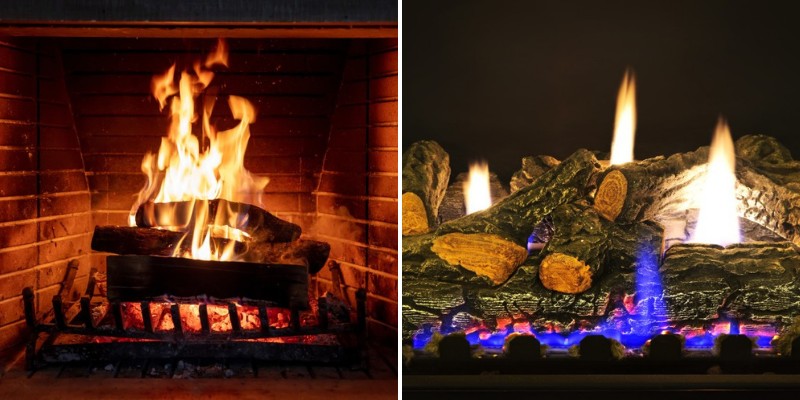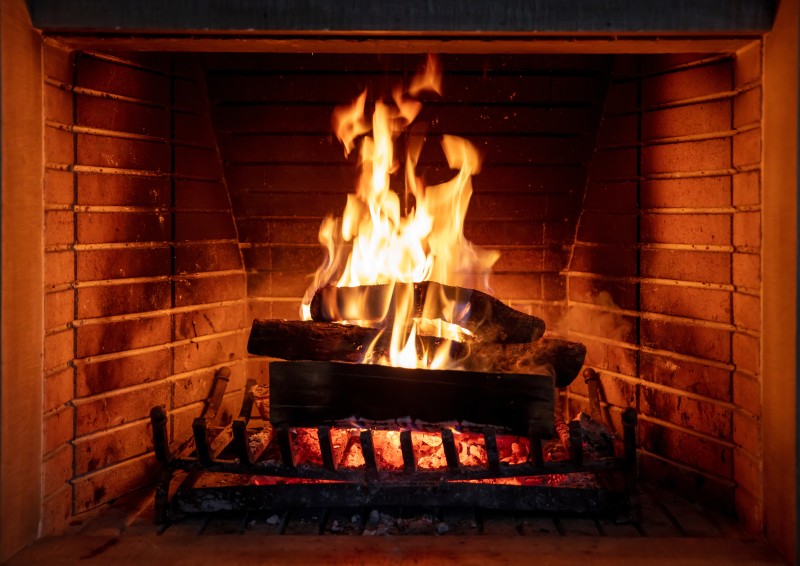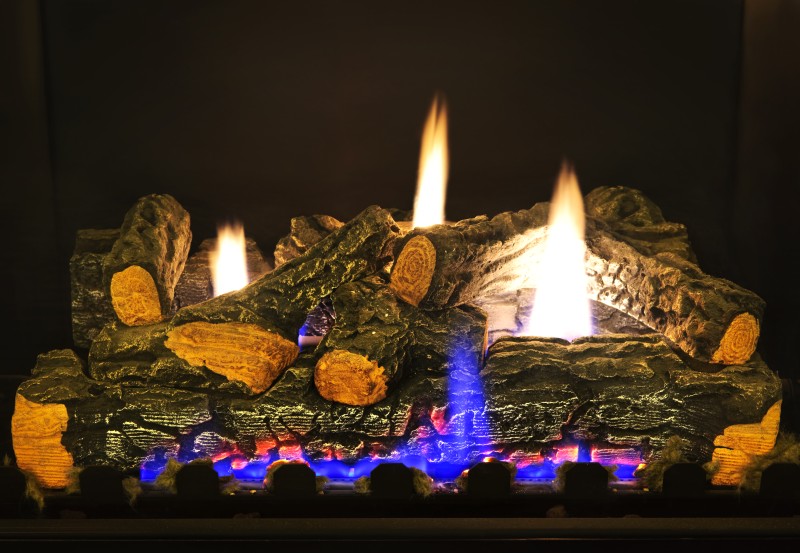It’s no mystery why homes with fireplaces are easier to sell, say real estate agents who place this feature atop their lists of selling points.

But did you know that scientists are great fans of fireplaces too? A study surveying 146 Swedish individuals with fireplaces in their homes resulted in a collection of fascinating data that was published in Science Direct.
Participants noted that fireplaces did more than keep them warm; they also provide emotional and restorative benefits that include these:
- Negative emotions like anger and stress may disappear.
- The brain’s depleted cognitive resources may be restored.
- By watching flames, blood pressure numbers drop.
- Socializing before a fireplace promotes friendlier, more creative discussions.
- Lighting a cozy fire has been proven to help people feel better all around.
Given so many benefits, your search for a fireplace may assume even more importance, and given two major choices that are currently available to you, it’s important to consider both before making your decision.
In this article we’ll discuss and compare Wood Burning vs Gas Fireplaces so you will be able to select the best option for you.
What is a Wood Burning Fireplace?
Wood burning fireplaces are the most rudimentary types of heating systems a home can have and for thousands of years – long before most of the HVAC systems now used in homes were invented – one or more fireplaces were the only heat sources for shops and homes.

Standard wood-burning fireplaces are comprised of a hearth (the floor in front of the fireplace), a firebox (interior enclosure that contains the logs) and a damper lever that opens and closes access to the flue so smoke can be vented through the chimney.
The diversity of fireboxes, hearths and flue systems on today’s market make adding a wood-burning fireplace to a home a relatively easy addition in the hands of the right contractor.
Pros of wood-burning Fireplace
- Lumber is readily available for purchase.
- The price of logs has remained relatively stable over time.
- Wood meets the criteria of being renewable and sustainable.
- Logs tend to be a cheaper way to heat compared to oil, gas or coal.
- There is no comparison when it comes to ambience and fragrance.
- It’s the closest experience to outdoor camping.
- Wood disburses fewer pollutants into the air than alternative fuels.
Cons of wood-burning Fireplace
- You can’t leave it unattended; a single spark could start a fire and constant stoking is required.
- If you intend to chop your own logs, be prepared for muscle aches.
- Annual cleanings are critical to eliminating toxic creosote buildup within the firebox.
- Buying and transporting lumber can be cumbersome if buying in bulk.
- Wood-burning fireplaces emit soot and smoke that can harm lungs if not properly vented.
- This heating method may be comforting but it’s not especially efficient.
- It takes more time for a fire’s warmth to be felt than with it does if you’ve a gas fireplace.
What is a Gas Fireplace?

Because the science, design and styling of gas fireplaces has expanded exponentially over time, you could be confronted with choices when you set off on your gas fireplace shopping spree, so it’s important to know about each to identify exactly the one that works best for your space, budget, and room style.
- Natural-vent (B-Vent) gas fireplaces draw air from interior rooms to feed flames that are vented through a chimney. These units are aesthetically pleasing, rustic and are closest to wood-burning fireplace types.
- Direct vent glass fireplaces feature a single opening that draws in fresh air and expels the product of combustion. Popular with folks who have no chimney, some of these feature blowers to assist airflow.
- Ventless gas fireplaces are known for their extremely clean burn and lack of dangerous elements thus a venting system isn’t required. Easy to install and energy efficient, not all ventless systems meet local building permit criteria.
- Standalone gas fireplaces. Because they operate away from walls as satellites, standalones require extra space. Available in a variety of styles, these can’t be inserted into wall cavities, but they come in vented and ventless types.
- See-through gas fireplaces. Most of these are ventless due to difficulties associated with running vent lines to walls. These are pricey but elegant and the most unusual option of all.
- Fireplace log sets. These artificial logs are confined to masonry fireboxes, offer the appearance of real burning wood and they are easy to clean. You’ll need a chimney to vent these types of logs.
Pros of Gas Fireplaces
- Flip a switch. That’s all you need do to start spreading warmth within a room.
- They’re wildly popular and easy to find. Around 70% of all hearth products are available in gas.
- You don’t have to lug logs, dump ashes, or put up with solid fuel hassles.
- Name an architectural style and you’ll find a gas fireplace the suits your décor.
- Inserts use natural gas or propane to deliver a steady flame and no log prodding is required.
- Both vented and unvented gas inserts require little maintenance beyond annual checks.
- Gas burning fireplaces can heat between 1,000 and 3,000 square feet depending upon size.
- For highest energy efficiency ratings, ventless inserts outperform vented systems.
Cons of Gas Fireplaces
- Exhaust fumes and moisture that are byproducts of ventless units can become trapped in rooms.
- Some states or communities don’t permit ventless gas fireplaces due to carbon monoxide emission concerns.
- Propane-driven gas fireplaces cost a fortune to operate – especially if you’re heating an entire house.
- You won’t get the same “snap, pop and fragrance” associated with wood fires.
- It’s expensive to run a new gas connection into a home to feed a gas fireplace.
- Gas fireplaces are not officially heating systems and may not be covered by homeowners’ insurance policies.
- Net zero laws in certain areas may mandate solar panels to compensate for heat generated by gas fireplaces.
- The Department of Energy and Environmental Protection Agency have begun to implement stringent laws surrounding their operation.
- This isn’t a DIY install. You’ll need a certified professional to do the job.
Comparison of Wood burning vs Gas Fireplace
Cost to Install
While the vast diversity in models, sizes, and styles – plus pricing differences found in varying regions of the nation – impact the purchase and installation of both types, these ballpark estimates can help you decide which makes the most financial sense:
Wood-Burning fireplace cost breakdown: Expect to spend around $30,000 total if you are installing a wood-burning fireplace from scratch (includes everything).
Between $1,000-$4,000 for the installation, and from $500 to $1000 for a new firebox. As you can tell, there is a vast range separating these extreme estimates.
Gas fireplace cost breakdown: Labor and materials will run between $1,500 and $3,000. You’ll spend another $1,500-$3,000 on the installation. Gas exhaust pipes add $500 to $1000. Choose gas and your total project costs will be between $4,000-$8,000.
Convenience
According to contractors and retailers who sell and install both, there is no debate: Gas fireplaces are more convenient than wood-burning types.
Wood management alone is the single most impactful element when comparing the two.
Operating a gas fireplace is so convenient, most models are one step away from delivering the warmth you crave: Turn on the gas and the heating starts.
You won’t even have to get out of your chair if you purchase a gas fireplace that can be controlled remotely.
Heating Efficiency
This comparison can be tricky since the size of the fireplace contributes greatly to heat output and room size is a factor as well.
As a rule, wood burning fireplaces offer larger blazes that generate more heat, but once extinguished, that heat dissipates fast.
Further, design plays a role. Since the back of a firebox reflects a substantial amount of heat, firebox interiors with more angles have the potential to generate more heat.
That stated, masonry fireplaces lose heat at a faster pace due to dissipation via the flue.
Ventless gas fireplaces supply low levels of heat for short periods of time and are not engineered to be a primary heat source for a room.
That stated, they are nearly 100% efficient when compared to wood fireplaces since little heat escapes.
Vented gas fireplaces, on the other hand, give off both radiant and convectional heat thus no warm air escapes. These systems feature air-movement channels that boost warmth.
Bottom line: “In the battle for most efficient fireplace, gas fireplace efficiency is always going to win over wood fireplace efficiency. That’s because gas fireplaces burn more cleanly and produce fewer polluting emissions,” say experts.
Maintenance and Cleaning
There’s not much to debate on this topic if you are too busy to deal with a wood-burning fireplace that requires you to handle wood, kindling, matches, newspapers, and the creosote buildup that must be removed to avoid a fire hazard if amassed within the firebox and chimney.
Wood fireplace cleaning is extremely labor intense, requiring ash removal that can set off respiratory reactions in people who are sensitive.
Alternately, gas fireplaces require cleaning but more infrequently; often just once a year will maintain the unit’s cleanliness.
One contractor summed this up best by saying, “in effect, you never have to clean your gas fireplace. But you always must clean your wood one. Never or always. That’s your choice.”
Installation
Industry experts agree that wood burning fireplaces are more challenging to install simply because the process of building a chimney from scratch is labor intensive while positioning a vent pipe that services gas models is easier.
Either should be handled by a professional, though more skilled labor is required if you choose a wood-burning fireplace since you’ll need a stone mason who knows his way around installing a firebox in addition to that chimney.
Further, if the fireplace is crafted of stone, installing firebricks and a chimney cap add to the cost.
All that’s required for a vent-type gas install is a small exhaust pipe and perhaps a blower to help circulate heat.
Appearance/Aesthetic
Believe it or not, not every homeowner is enamored with the idea of the homey, warm feeling only a blazing, wood-driven fire delivers, but for those who will settle for nothing less, the ambiance of a log-burning unit has no equal.
Even a rustic wood box that stows logs adds to the charm of this type of fireplace.
If you would be just as delighted to enjoy dancing flames and a quiet glow, a gas-burning fireplace should do the job – especially given the expansive numbers of colors, styles and features incorporated into contemporary gas fireplace designs.
While gas units don’t offer the distinct smell and signature popping sound of wood fires, artificial sound may fill that void nicely, so check out units with extra features when you shop.
Resources
https://www.sciencedirect.com/science/article/pii/S2214629620302711
http://mychimpro.com/everything-you-need-to-know-wood-fireplaces/
https://croftfireplace.com/whats-the-difference-between-a-gas-fireplace-a-gas-insert-and-gas-logs/
https://www.familyhandyman.com/article/gas-fireplaces-types/
https://www.houselogic.com/organize-maintain/home-maintenance-tips/gas-fireplace-inserts-pros-cons/
https://www.brickandember.com/advantages-disadvantages-gas-fireplace/
https://www.thebioflame.com/end-gas-fireplace-near/
https://fireplaceuniverse.com/is-a-gas-fireplace-worth-it/
https://www.dbsincaz.com/gas-vs-wood-fireplace/
https://www.acucraft.com/gas-fireplaces-vs-wood-fireplaces/
https://hamiltonhomecomfort.com/type-fireplace-gives-heat/
https://blog.constellation.com/2017/02/24/gas-wood-fireplace-comparison/
https://www.bandccomfort.com/gas-vs-wood-fireplace/
https://www.fixr.com/comparisons/wood-vs-gas-fireplace
Related Posts
- How to Stop Sliding Doors from Rattling – Causes and Solutions
- Cheap Ways to Heat a Room – Efficient and Budget-Friendly Solutions
- 11 Ways to Get Rid of Cooking Smells in a Small Apartment or House
- 11 Stores and Sites Like IKEA For Affordable Furniture and Home Products
- All About Polypropylene – Olefin Fabric Sofa Material
- 12 Different Types of Wood for Outdoor Furniture with Pros/Cons
Leave a Reply